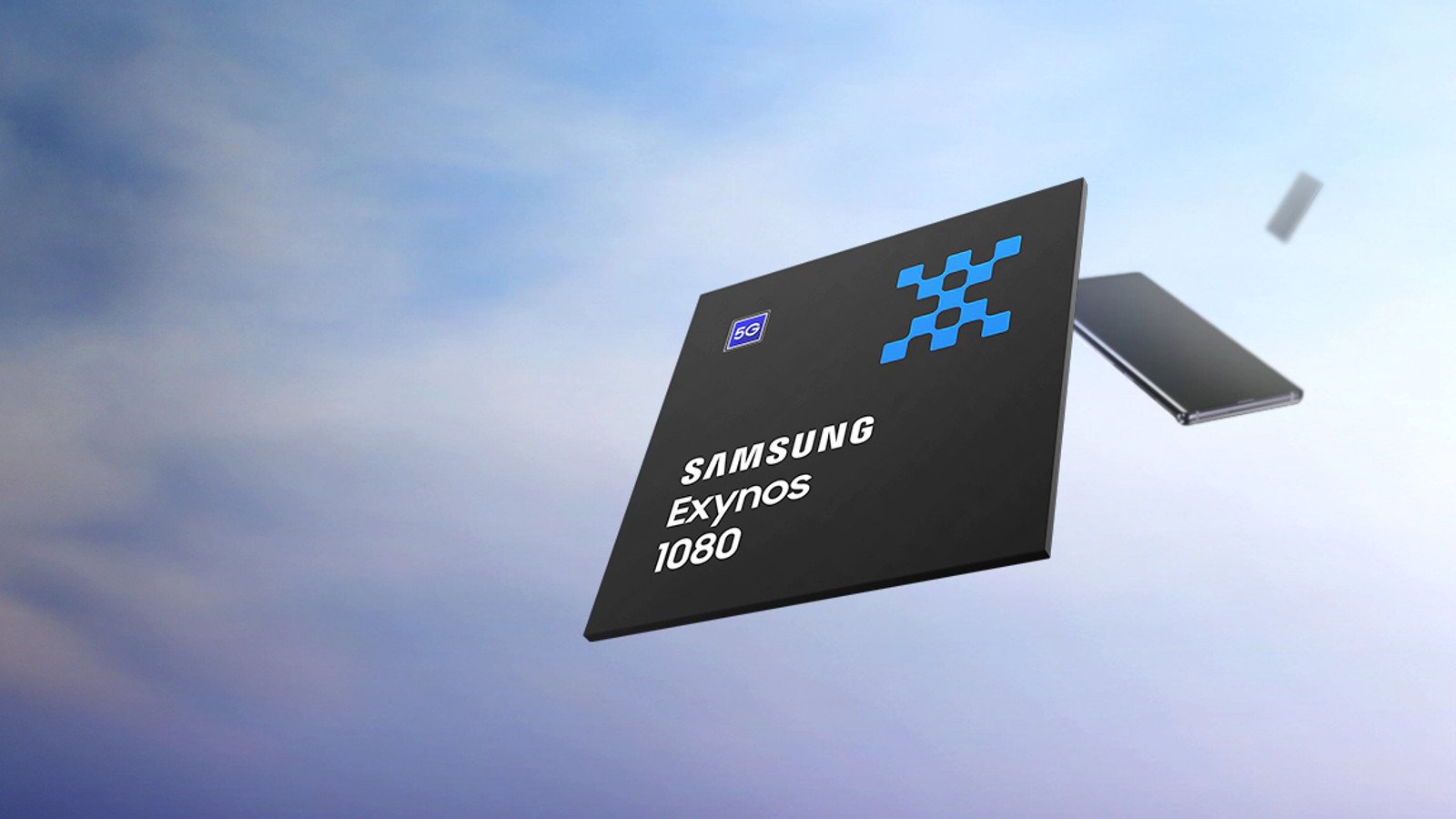The Exynos 1080 was announced last week, and it is Samsung’s first 5nm mobile chipset. Usually, the South Korean tech giant debuts its latest fabrication process with its flagship processor, but this time the company decided to debut the 5nm process with its mid-range chipset. And this step alone could mean a drastic change in Samsung’s strategy. The Exynos 1080 could very well mark Samsung’s return to competitiveness in the mobile chipset game.
The Exynos 1080 brings various improvements over the Exynos 980 that was announced last year. The new SoC uses four Cortex-A78 CPU cores, four Cortex-A55 CPU cores, the Mali-G78 MP10 GPU, and an integrated NPU for AI processing.
Exynos 1080’s 5nm process & A78 cores mean huge CPU performance bump
Compared to just two high-performance Cortex-A77 CPU cores in the Exynos 980, the Exynos 1080 uses four high-performance cores, and ARM claims that Cortex-A78 cores offer 20% higher performance under sustained workloads. So, the Exynos 1080’s peak and sustained performance should be substantially higher than that of the Exynos 980.
Combining a newer architecture with the 5nm process, Samsung is claiming a performance improvement of 50% in single-core workloads and a 2x jump in multi-core performance. The Exynos 1080’s performance would most likely be even better than the Exynos 990 due to its newer architecture and slightly higher frequencies.
The Exynos 1080 also supports LPDDR5 RAM and ultra-fast UFS 3.1 storage compared to Exynos 980’s support for older LPDDR4X RAM and UFS 2.1 storage.
Mali-G78 GPU theoretically features better performance, efficiency
Going by ARM’s claims, the Mali-G78 GPU has a 15% higher performance and 10% better power efficiency compared to the Mali-G77 GPU. Huawei’s Kirin 9000 chipset, which features the same Mali-G78 GPU, has shown promising performance in test results, beating the Snapdragon 865’s Adreno 650 GPU. However, Huawei uses a 24-core version of the Mali-G78, but the Exynos 1080 uses an 11-core configuration. So, we can only know its graphics performance after some real-life tests.
The GPU, combined with the new display driver, offers support for high refresh rate displays. It could mean that we can finally see mid-range Galaxy devices with high refresh rate screens. The Exynos 1080 supports QHD+ displays with a 90Hz refresh rate and Full HD+ displays with up to a whopping 144Hz refresh rate. That’s even better than the Exynos 990’s 120Hz refresh rate support. The Exynos 1080 lacks support for 4K screens, though, but do we really need 4K screens on smartphones? We don’t think so. This is where Samsung appears to have cut meaningful corners.
The new dedicated NPU and DSP inside the Exynos 1080 offer up to 5.7 tera operations per second (TOPS), but it’s not as good as the Exynos 990’s dual-core NPU.
First mid-range Exynos SoC to feature support for 200MP cameras, HDR10+ video recording
The Exynos 1080 is Samsung’s first mid-range processor to feature support for 200MP camera sensors. It supports up to six cameras and can obtain simultaneous image streams from two 32MP cameras. That’s even better than the Exynos 990’s ISP. Samsung has downgraded the Exynos 1080’s MFC, though, which can go only as high as 4K/60fps video recording and decoding. The Exynos 980 was capable of encoding and decoding up to 4K/120fps videos.
Samsung’s first chipset with an integrated modem that supports mmWave 5G
The Exynos 1080 comes with a fully-integrated modem that supports both sub-6GHz 5G and mmWave 5G, and can reach theoretical download and upload speeds of up to 3.67Gbps. In comparison, the Exynos 980 only supports sub-6GHz 5G and the Exynos 990 needs a separate modem to connect to 5G networks.
The Exynos 1080 also supports dual-band Wi-Fi 6, Bluetooth 5.2, GPS, BDS, Galileo, and GLONASS. The new chipset’s connectivity suite is better than any other Exynos chipset that Samsung has ever launched.
On paper, the Exynos 1080 looks like a huge upgrade over the Exynos 980 in almost all aspects, including CPU, GPU, AI, and memory performance. It’s ISP is better and its connectivity is faster. Thanks to its 5nm process, its power efficiency should be much better, too. It even supports up to 144Hz displays and has an integrated 5G modem. Except for the downgraded video encoding and decoding chops, Exynos 1080 is even better than the Exynos 990 processor.
The first smartphone to use the Exynos 1080 will be from Vivo, and its review should give us a better idea about its performance, power efficiency, and connectivity. Even Samsung’s own premium mid-range smartphones from the Galaxy A series are expected to use the Exynos 1080, and they could offer much better performance than the Exynos 980-equipped Galaxy A51 5G and Galaxy A71 5G.
| Exynos 1080 | Exynos 980 | Exynos 990 | |
| Process | 5nm LPE EUV | 8nm LPP | 7nm LPP EUV |
| CPU | 1x Cortex-A78 @ 2.8GHz
3x Cortex-A78 @ 2.6GHz 4x Cortex-A55 @ 2GHz |
2x Cortex-A77 @ 2.2GHz
6x Cortex-A55 @ 1.8GHz |
2x Mongoose M5 @ 2.73GHz
2x Cortex-A76 @ 2.5GHz 4x Cortex-A55 @ 2GHz |
| GPU | Mali-G78 MP10 | Mali-G76 MP5 | Mali-G77 MP11 |
| Display | WQHD+ @ 90Hz
Full HD+ @ 144Hz HDR10+ |
WQHD+ @ 60Hz | 4K @ 60Hz
QHD+ @ 120Hz HDR10+ |
| AI Processor | NPU + DSP = 5.7 TOPS | NPU + DSP = ? TOPS | Dual-Core NPU + DSP = 15 TOPS |
| Memory | LPDDR5
LPDDR4X |
LPDDR4X | LPDDR5 |
| Storage | UFS 3.1 | UFS 2.1, eMMC 5.1 | UFS 3.0, UFS 2.1 |
| Camera | Single: 200MP
Dual: 32MP+32MP Up To 6 Cameras |
Single: 108MP
Dual: 20MP+20MP |
Single: 108MP
Dual: 24.8MP+24.8MP Up To 3 Cameras At Once Up To 6 Cameras |
| Video Capture | 4K/60fps
10-Bit HDR10+ |
4K/120fps
10-Bit HDR10+ |
8K/30fps
4K/120fps Bokeh Mode HDR10+ |
| Video Playback | Up To 4K/60fps
10-Bit HDR10+ |
4K/120fps
10-Bit HDR10+ |
8K/30fps
4K/120fps 10-Bit HDR10+ |
| 5G Modem | Integrated 5G Modem
mmWave, sub-6GHz |
Integrated 5G Modem
sub-6GHz |
Not Integrated
(Needs Separate Exynos 5123 Modem) |
| GPS | BeiDou, Galileo, GLONASS, GPS | BeiDou, Galileo, GLONASS, GPS | BeiDou, Galileo, GLONASS, GPS |
| Wi-Fi | Wi-Fi 6 | Wi-Fi 6 | Wi-Fi 6 |
| Bluetooth | Bluetooth 5.2 | Bluetooth 5.0 | Bluetooth 5.0 |







